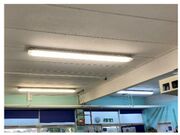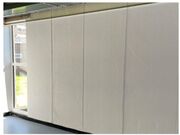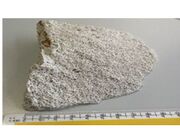Difference between revisions of "Reinforced autoclaved aerated concrete"
| (2 intermediate revisions by the same user not shown) | |||
| Line 3: | Line 3: | ||
[[File:RAAC concrete fragment.jpg|thumb|RAAC fragment<br>Department of Education (UK) report: [https://community.culturalheritage.org/HigherLogic/System/DownloadDocumentFile.ashx?DocumentFileKey=790694ad-3963-4926-86ea-f4821752715f RAAC Guide]]] | [[File:RAAC concrete fragment.jpg|thumb|RAAC fragment<br>Department of Education (UK) report: [https://community.culturalheritage.org/HigherLogic/System/DownloadDocumentFile.ashx?DocumentFileKey=790694ad-3963-4926-86ea-f4821752715f RAAC Guide]]] | ||
==Description== | ==Description== | ||
| − | A lightweight, ‘bubbly’ form of concrete masonry blocks and pre-cast panels commonly used in construction between the 1950s and mid-1990s. Autoclaved Aerated Concrete (AAC) | + | A lightweight, inexpensive, ‘bubbly’ form of concrete masonry blocks and pre-cast panels commonly used in construction between the 1950s and mid-1990s. Autoclaved Aerated Concrete (AAC) is made with fine aggregates, cement, and an expansion agent that produces concrete containing 80 percent air. The mixture is poured into molds with a steel reinforcement (RAAC) network, left to rise, then "baked' with high heat, steam and pressure to complete the chemical curing process. The initial result was a lightweight material with excellent sound and thermal insulation, and like all cement-based materials, was strong and fire resistant. However, with age, RAAC has been found to have poor load-bearing ability and weak bonding with its embedded metal reinforcement. |
| + | |||
| + | RAAC pre-cast panels were predominantly used in in roofs (commonly flat roofs, sometimes pitched) and occasionally in floors and walls. The panels are light-grey or white in appearance, with a smooth, paintable surface. The inside of the planks will appear bubbly, often described as looking like an Aero bar. Unlike traditional concrete, there will not be visible stones (coarse aggregate) in the panels. The panels have distinctive V-shaped grooves at at the connection points (every 600 mm). A bituminous or latex coating was sometimes added as a water barrier. | ||
== Synonyms and Related Terms == | == Synonyms and Related Terms == | ||
| Line 11: | Line 13: | ||
* Cracking and spalling | * Cracking and spalling | ||
* Load-bearing failure | * Load-bearing failure | ||
| − | * Corrosion of | + | * Corrosion of metal reinforcements |
* Movement and deflections of panels | * Movement and deflections of panels | ||
| Line 21: | Line 23: | ||
* Department of Education (UK): [https://community.culturalheritage.org/HigherLogic/System/DownloadDocumentFile.ashx?DocumentFileKey=790694ad-3963-4926-86ea-f4821752715f RAAC: Government Identification guide] | * Department of Education (UK): [https://community.culturalheritage.org/HigherLogic/System/DownloadDocumentFile.ashx?DocumentFileKey=790694ad-3963-4926-86ea-f4821752715f RAAC: Government Identification guide] | ||
* Structural-Safety: [https://www.cross-safety.org/sites/default/files/2019-05/failure-reinforced-autoclaved-aerated-concrete-planks.pdf Failure of RAAC] | * Structural-Safety: [https://www.cross-safety.org/sites/default/files/2019-05/failure-reinforced-autoclaved-aerated-concrete-planks.pdf Failure of RAAC] | ||
| − | + | * Wikipedia: [https://en.wikipedia.org/wiki/Reinforced_autoclaved_aerated_concrete Reinforced Autoclaved Aerated Concrete] Accessed August 2023 | |
[[Category:Materials database]] | [[Category:Materials database]] | ||
Latest revision as of 08:14, 12 September 2023
Description
A lightweight, inexpensive, ‘bubbly’ form of concrete masonry blocks and pre-cast panels commonly used in construction between the 1950s and mid-1990s. Autoclaved Aerated Concrete (AAC) is made with fine aggregates, cement, and an expansion agent that produces concrete containing 80 percent air. The mixture is poured into molds with a steel reinforcement (RAAC) network, left to rise, then "baked' with high heat, steam and pressure to complete the chemical curing process. The initial result was a lightweight material with excellent sound and thermal insulation, and like all cement-based materials, was strong and fire resistant. However, with age, RAAC has been found to have poor load-bearing ability and weak bonding with its embedded metal reinforcement.
RAAC pre-cast panels were predominantly used in in roofs (commonly flat roofs, sometimes pitched) and occasionally in floors and walls. The panels are light-grey or white in appearance, with a smooth, paintable surface. The inside of the planks will appear bubbly, often described as looking like an Aero bar. Unlike traditional concrete, there will not be visible stones (coarse aggregate) in the panels. The panels have distinctive V-shaped grooves at at the connection points (every 600 mm). A bituminous or latex coating was sometimes added as a water barrier.
Synonyms and Related Terms
RAAC; Reinforced AAC
Risks
- Cracking and spalling
- Load-bearing failure
- Corrosion of metal reinforcements
- Movement and deflections of panels
Forms and Sizes
- Typically 600 mm wide panels
Resources and Citations
- Conservation Distlist: RAAC concrete thread Accessed August 2023
- Department of Education (UK): RAAC: Government Identification guide
- Structural-Safety: Failure of RAAC
- Wikipedia: Reinforced Autoclaved Aerated Concrete Accessed August 2023


